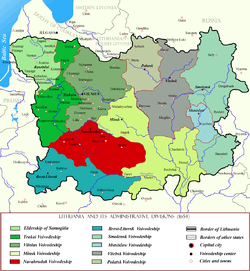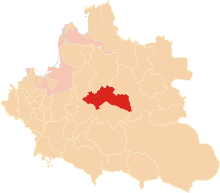Nowogródek Voivodeship (1507–1795)
| Nowogródek Voivodeship Palatinatus Novogrodensis Województwo nowogródzkie | |||||
| Voivodeship of the Grand Duchy of Lithuania, later Polish-Lithuanian Commonwealth | |||||
| |||||
|
Coat of arms | |||||
 | |||||
| Capital | Nowogródek | ||||
| History | |||||
| • | Established | 1507 | |||
| • | Third partition of the Polish–Lithuanian Commonwealth | 1795 | |||
| Area | 33,200 km2 (12,819 sq mi) | ||||
| Political subdivisions | counties: three, and the Duchy of Sluck and Kopyl | ||||
Nowogródek Voivodeship (Polish: województwo nowogródzkie, Lithuanian: Naugarduko vaivadija, Belarusian: Навагрудзкае ваяводзтва, Latin: Palatinatus Novogrodensis) was a unit of administrative division of the Grand Duchy of Lithuania (from 1507) and of the Polish–Lithuanian Commonwealth (from 1569), with the capital in the town of Nowogródek (now Belarus).
History

The Voivodeship was composed of three counties, Nowogródek, Wołkowysk, Słonim, as well as the Duchy of Słuck. It had two senators, two deputies for the Sejm, and two deputies for the Lithuanian Tribunal. Its capital was the town of Nieśwież with the castle and treasury of the Radziwiłł family.[1] Nowogródek Voivodeship ceased to exist along with the sovereign state of Poland following the three Partitions of Poland, perpetrated by the neighboring empires towards the end of 18th century (1772, 1793, 1795).[2]
Zygmunt Gloger in his monumental book Historical Geography of the Lands of Old Poland provides this description of the Nowogródek Voivodeship:
“Slavic lands along the upper Niemen, after collapse of the Kievan Rus’ were in 1241 ransacked by the forces of the Mongol Empire, under Batu Khan. After the Mongol raid, it turned into a desert, and was annexed by the Grand Duchy of Lithuania. In c. 1500, local Lithuanian dukes were named voivodes, thus Nowogródek Voivodeship was created. Like the neighbouring Brest Litovsk Voivodeship, Nowogródek Voivodeship was rather narrow but very long, stretching from the upper Narew and Bialowieza Forest, to the spot where the Ptsich flows into the Pripyat (...)
Nowogródek Voivodeship was divided into three counties: those of Nowogródek, Wolkowysk, and Slonim. Furthermore, it included the Duchy of Sluck and Kopyl. Each county had its own sejmik, with each electing two deputies to the Sejm, and two to the Lithuanian Tribunal. It had only two senators, who were the Voivode and the Castellan of Nowogródek (...) Northern part of the voivodeship, mainly the County of Nowogródek and the Duchy of Sluck were among most fertile lands in Lithuania, with hilly landscape and several beautiful towns, such as Tuhanowicze, Switez and Woroncza".
Voivodes
- Martynas Goštautas (Marcin Gasztołdowicz; 1464–1471), appointed by King Casimir Jagiellon
- Albrecht Goštautas (1508–1514), to King Sigismund I the Old
- Jan Zabrzeziński (1514–1530)
- Stanislovas Goštautas (Stanisław Gasztołd, 1530–1542), to King Sigismund II Augustus
- Grzegorz Ostik (1542–1544)
- Aleksander Chodkiewicz (1544–1549)
- Alexander Polubinsky (1549–1151)
- Ivan Ermine (1551–1558)
- Paweł Sapieha (1558–1579)
- Mikołaj VII Radziwiłł (1579–1590)
- Teodor Skumin Tyszkiewicz (1590–1618)
- Mikołaj Sapieha (1618–1638), to King Sigismund III Vasa
- Aleksander Słuszka (1638–1643)
- Tomasz Sapieha (I 1643–IV 1646)
- Jury Hreptovich (1646–1650)
- Nicholas Kshiftof Khaletskaya (1650–1653)
- Peter Kazimierz Vezhevich (1653–1658)
- Krzysztof Wołodkowicz Family (1658–1670)
- Jan Kersnovskaya (1670)
- Dmitrij Polubinsky (1670–1689)
- Alexander Bohuslav Unehovsky (1689)
- Stefan Tyzenhauz (1689–1709)
- Jan Mikołaj Radziwiłł (1709–1729)
- Mikołaj Faustin Radziwiłł (1729–1746)
- Jerzy Radziwiłł (1746–1754)
- Józef Aleksander Jabłonowski (1754–1773)
- Józef Niesiołowski (1773–1795)
See also
Notes and references
- ↑ Nowogrodek Voivodeship, description by Zygmunt Gloger. Geografia historyczna ziem dawnej Polski.
- ↑ Żmigrodzki J. "Nowogródek i okolice". Nowogródek, 1931. Nakładem Nowogródzkiego Oddziału Polsk. Tow. Krajoznawczego z zasiłkiem Ministerstwa Robót Publicznych. Retrieved August 5, 2011.
Coordinates: 53°36′06″N 25°49′38″E / 53.601723°N 25.827310°E


